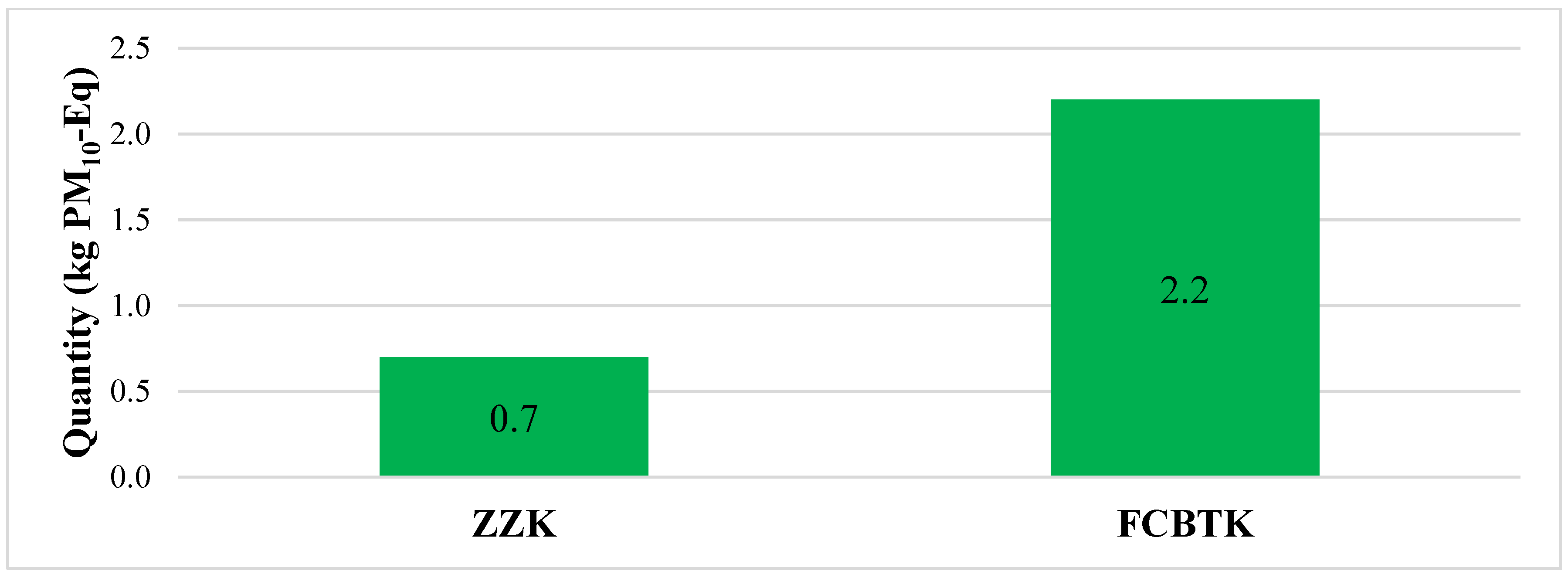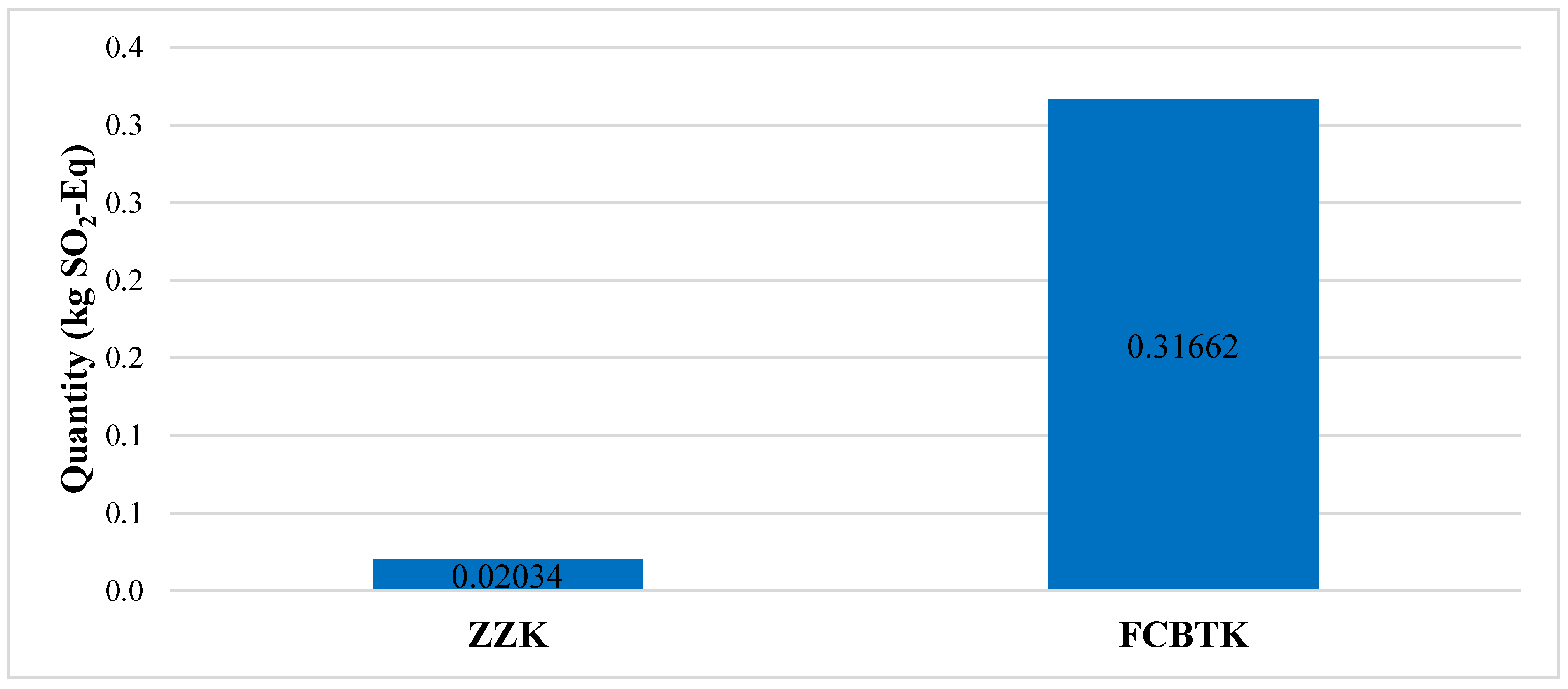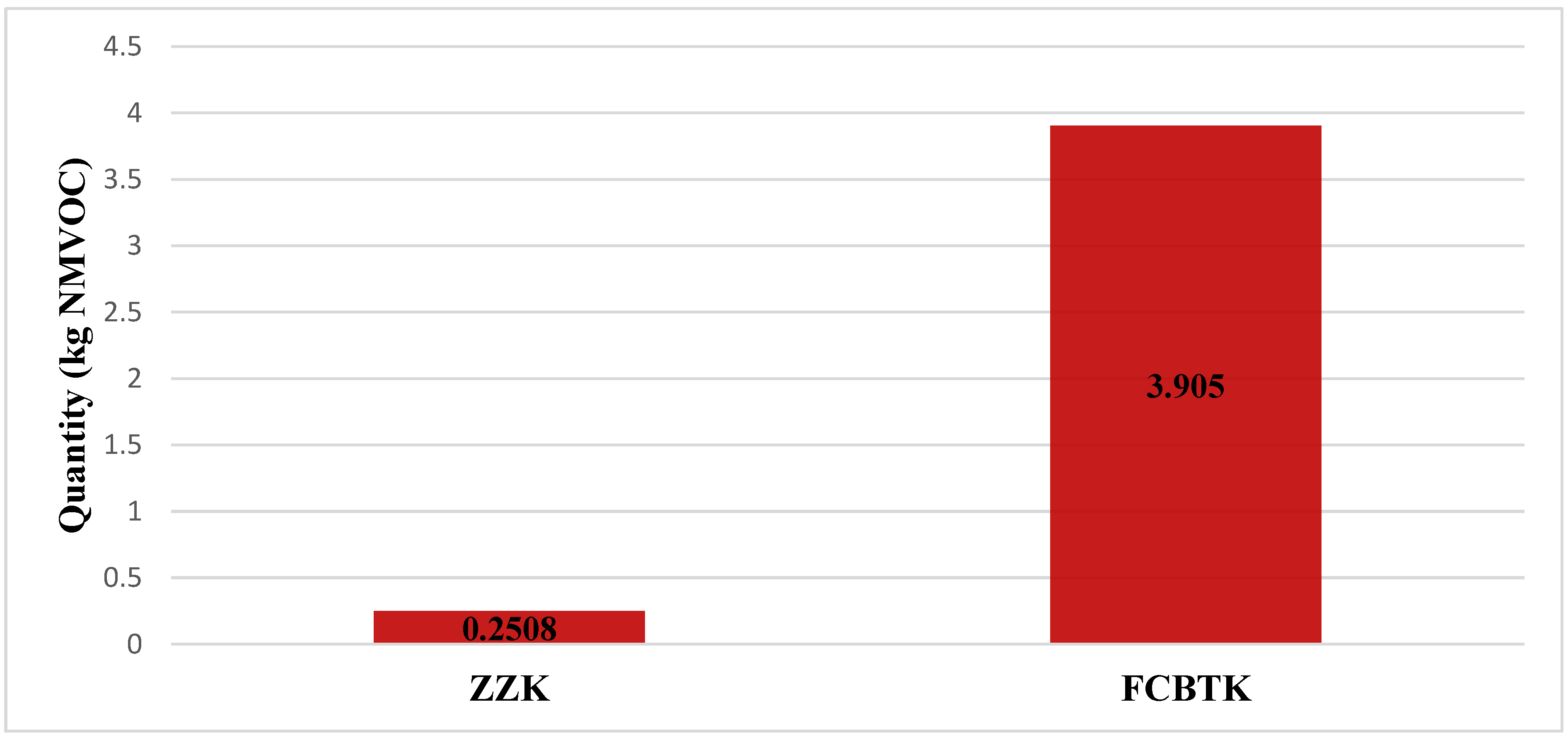Investigating the Impact of Shifting the Brick Kiln Industry from Conventional to Zigzag Technology for a Sustainable Environment
Abstract
:1. Introduction
2. Methodology
3. Results and Discussion
3.1. Analysis of Specific Energy Consumption
3.1.1. Specific Energy Consumption in Fixed Chimney Bull’s Trench Kilns
3.1.2. Specific Energy Consumption in Zigzag Kilns
3.2. Emission Analysis
3.2.1. Reduction in CO Emissions through Retrofitting Measures
3.2.2. Reduction in CO2 Emissions
3.2.3. Reduced Sulfur Dioxide Emissions
3.2.4. Reduced PM2.5 Emissions
3.2.5. Reduction in Black Carbon Emissions
3.3. Analysis of Impact Categories
3.3.1. Particulate Matter Formation

3.3.2. Photochemical Oxidant Formation

3.3.3. Terrestrial Acidification

4. Conclusions
Author Contributions
Funding
Institutional Review Board Statement
Informed Consent Statement
Data Availability Statement
Acknowledgments
Conflicts of Interest
Nomenclature
| AQI | Air Quality Index |
| BC | Black Carbon |
| BKOAP | Brick Kiln Owners Association of Pakistan |
| FCBTK | Fixed Chimney Bull’s Trench Kiln |
| GHG | Greenhouse Gases |
| HHK | Hybrid Hoffmann Kiln |
| ICIMOD | International Centre for Integrated Mountain Development |
| IDZK | Induced Draft Zigzag Kiln |
| LCA | Life Cycle Assessment |
| NEECA | National Energy Efficiency and Conservation Authority |
| PM | Particulate Matter |
| PMF | Particulate Matter Formation |
| POF | Photochemical Oxidant Formation |
| SEC | Specific Energy Consumption |
| TA | Terrestrial Acidification |
| TK | Tunnel Kiln |
| VSBK | Vertical Shaft Bull’s Trench Kiln |
| ZZK | Zigzag Kiln |
References
- Lee, J. Cost evaluation methodology that can be used in a 3D architectural design environment. Int. J. Adv. Res. Eng. Technol. 2020, 11, 97–103. [Google Scholar]
- Brick Development Association. Sustainability Report Chairman’s Summary. 2019. Available online: https://www.brick.org.uk/uploads/downloads/Sustainability-Report-2019.pdf (accessed on 26 February 2023).
- Pervaiz, S.; Ameer, M.; Akram, N.; Khan, F.Z.; Javid, K. Brick Sector and Air Quality: An Integrated Assessment towards 2020 Challenge of Environment Development. Environ. Nat. Resour. J. 2021, 19, 153–164. [Google Scholar] [CrossRef]
- Ncube, A.; Matsika, R.; Mangori, L.; Ulgiati, S. Moving towards resource efficiency and circular economy in the brick manufacturing sector in Zimbabwe. J. Clean. Prod. 2021, 281, 125238. [Google Scholar] [CrossRef]
- Kumbhar, S.; Kulkarni, N.; Rao, A.B.; Rao, B. Environmental life cycle assessment of traditional bricks in western Maharashtra, India. Energy Procedia 2014, 54, 260–269. [Google Scholar] [CrossRef]
- World Population Prospects 2022. 2022. Available online: https://population.un.org/wpp/ (accessed on 26 February 2023).
- Abdul, S.; Al-motairi, H.; Tahir, F.; Al-fagih, L. Incentives and strategies for financing the renewable energy transition: A review. Energy Rep. 2021, 7, 3590–3606. [Google Scholar] [CrossRef]
- Ali, M.; Wazir, R.; Imran, K.; Ullah, K.; Janjua, A.K.; Ulasyar, A.; Khattak, A.; Guerrero, J.M. Techno-economic assessment and sustainability impact of hybrid energy systems in Gilgit-Baltistan, Pakistan. Energy Rep. 2021, 7, 2546–2562. [Google Scholar] [CrossRef]
- Adopt, T.; Environmental, A. To Adopt, or Not to Adopt, Why is the Question: An Environmental and Economic Case for Zigzag. Available online: https://cdpr.org.pk/wp-content/uploads/2019/04/010819-SN-IGC-Brick-Kiln-Project.pdf (accessed on 26 February 2023).
- Elsoragaby, S.; Yahya, A.; Razif, M.; Mat, N. Applying multi-objective genetic algorithm (MOGA) to optimize the energy inputs and greenhouse gas emissions (GHG) in wetland rice production. Energy Rep. 2020, 6, 2988–2998. [Google Scholar] [CrossRef]
- Government of Pakistan. 2020. Available online: https://www.solidaritycenter.org/wp-content/uploads/2021/03/Pakistan.Report.Forced-labor-in-the-brick-kilns.pdf (accessed on 26 February 2023).
- Lin, B.; Raza, M.Y. Coal and economic development in Pakistan: A necessity of energy source. Energy 2020, 207, 118244. [Google Scholar] [CrossRef]
- Jain, P.; Bansal, S. Brick Kilns, Anemia & Residential Proximity: Evidence from Bihar. Available online: https://www.isid.ac.in/~epu/acegd2022/papers/Parul_Jain.pdf (accessed on 26 February 2023).
- Maraveas, C. Production of sustainable construction materials using agro-wastes. Materials 2020, 13, 262. [Google Scholar] [CrossRef]
- Lakshmi, N. Issue 2 Page 780 International Journal of Community Medicine and Public Process evaluation of mission Indradhanush immunization program in urban and rural communities of Ahmedabad district of Gujarat. Int. J. Community Med. Public Health 2022, 2, 2–6. [Google Scholar]
- Anwar, M.N.; Shabbir, M.; Tahir, E.; Iftikhar, M.; Saif, H.; Tahir, A.; Murtaza, M.A.; Khokhar, M.F.; Rehan, M.; Aghbashlo, M.; et al. Emerging challenges of air pollution and particulate matter in China, India, and Pakistan and mitigating solutions. J. Hazard. Mater. 2021, 416, 125851. [Google Scholar] [CrossRef] [PubMed]
- Zavala, M.; Molina, L.T.; Maiz, P.; Monsivais, I.; Chow, J.C.; Watson, J.G.; Munguia, J.L.; Cardenas, B.; Fortner, E.C.; Herndon, S.C.; et al. Black carbon, organic carbon, and co-pollutant emissions and energy efficiency from artisanal brick production in Mexico. Atmos. Chem. Phys. 2018, 18, 6023–6037. [Google Scholar] [CrossRef]
- Galliero, G.; Volz, S.; Galliero, G.; Volz, S. Thermodiffusion in model nanofluids by molecular dynamics simulations. J. Chem. Phys. 2008, 128, 064505. [Google Scholar] [CrossRef] [PubMed]
- Allen, M.R.; Stocker, T.F. Dioxide emissions. Nat. Clim. Chang. 2014, 4, 23–26. [Google Scholar] [CrossRef]
- Urbana-champaign, I. Brick Kiln Measurement Guidelines: Emissions and Energy Performance. 2016. Available online: https://www.ccacoalition.org/sites/default/files/resources/BC_BrickKilns_GuidanceDocument_Final.pdf (accessed on 26 February 2023).
- Nations, U.; Programme, E. Brick Kiln Emission-Energy Study in Pakistan. 2019. Available online: https://www.mdpi.com/2071-1050/12/18/7724 (accessed on 26 February 2023).
- No New Brick Kiln to Be Allowed Sans Zig-Zag Firing Tech: EPD. DAWN. Available online: https://www.dawn.com/news/1408569 (accessed on 26 February 2023).
- ICIMOD. Building Back Better Brick Kilns in Nepal. 2016, pp. 2015–2016. Available online: http://lib.icimod.org/record/32300 (accessed on 26 February 2023).
- Mehrparvar, A.H.; Hossein Davari, M.; Mollasadeghi, A.; Reza Vahidi, M.; Mostaghaci, M.; Bahaloo, M.; Shokouh, P. Case Report Hearing Loss due to Carbon Monoxide Poisoning. Case Rep. Otolaryngol. 2013, 2013, 14–17. [Google Scholar]
- Sulfur Dioxide Effects. EPA. Available online: https://archive.epa.gov/clearskies/web/pdf/overview.pdf (accessed on 26 February 2023).
- Zhang, H.; Magara-Gomez, K.T.; Olson, M.R.; Okuda, T.; Walz, K.A.; Schauer, J.J.; Kleeman, M.J. Science of the Total Environment Atmospheric impacts of black carbon emission reductions through the strategic use of biodiesel in California. Sci. Total Environ. 2015, 538, 412–422. [Google Scholar] [CrossRef]
- Solomon, S. Risks to the stratospheric ozone shield in the Anthropocene This article belongs to Ambio’s 50th Anniversary Collection. Theme: Ozone Layer. Ambio 2021, 50, 44–48. [Google Scholar] [CrossRef] [PubMed]
- Methane: A Crucial Opportunity in the Climate Fight. Available online: https://www.edf.org/climate/methane-crucial-opportunity-climate-fight (accessed on 26 February 2023).
- Publications of the Institute of Geophysics Polish Academy of Sciences. 2020, Volume 429. Available online: https://pub.igf.edu.pl (accessed on 26 February 2023).
- ISO 14040 2006; Environmental Management—Life Cycle Assessment—Principles and Framework. ISO: London, UK, 2006.
- Santos, S.D.F.d.O.M.; Piekarski, C.M.; Ugaya, C.M.L.; Donato, D.B.; Júnior, A.B.; De Francisco, A.C.; Carvalho, A.M.M.L. Life Cycle Analysis of Charcoal Production in Masonry Kilns with and without Carbonization Process Generated Gas Combustion. Sustainability 2017, 9, 1558. [Google Scholar] [CrossRef]
- Mendes, L.; De Francisco, A.C.; Piekarski, C.M.; Salvador, R. Integrating life cycle assessment in the product development process: A methodological approach. J. Clean. Prod. 2018, 193, 28–42. [Google Scholar] [CrossRef]
- Salvador, R.; Piekarski, C.M.; Mendes, L.; De Francisco, A.C. Life Cycle Assessment of Electricity from Biogas: A Systematic Literature Review. Environ. Prog. Sustain. Energy 2019, 38, 13133. [Google Scholar] [CrossRef]
- Koroneos, C.; Dompros, A. Environmental assessment of brick production in Greece. Build. Environ. 2007, 42, 2114–2123. [Google Scholar] [CrossRef]
- Huarachi, D.A.R.; Gonçalves, G.; de Francisco, A.C.; Canteri, M.H.G.; Piekarski, C.M. Life cycle assessment of traditional and alternative bricks: A review. Environ. Impact Assess. Rev. 2020, 80, 106335. [Google Scholar] [CrossRef]
- Galan-marin, C.; Rivera-gomez, C.; Garcia-martinez, A. Use of Natural-Fiber Bio-Composites in Construction versus Traditional Solutions: Operational and Embodied Energy Assessment. Materials 2016, 9, 465. [Google Scholar] [CrossRef] [PubMed]
- Huang, B.; Chen, Y.; Mcdowall, W.; Türkeli, S.; Bleischwitz, R. Embodied GHG emissions of building materials in Shanghai. J. Clean. Prod. 2019, 210, 777–785. [Google Scholar] [CrossRef]

| Material | Quantity | |
|---|---|---|
| FCBTKs | ZZKs | |
| Soil | 3000 kg | 3000 kg |
| Water | 1 m3 | 1 m3 |
| Sand | 50 kg | 50 kg |
| Coal | 275 kg | 220 kg |
| Electricity | 10 kWh | 10 kWh |
| Pollutant | Quantity (g/kg of Fuel) | |
|---|---|---|
| FCBTKs | ZZKs | |
| CO | 6600 | 3036 |
| CO2 | 448,250 | 310,200 |
| SO2 | 3905 | 250.8 |
| PM2.5 | 1485 | 770 |
| Carbon Black | 101.7 | 13.2 |
| Pollutant | Kiln Type | |
|---|---|---|
| FCBTK | ZZK | |
| CO (g/kg) | 24 | 13.8 |
| CO2 (g/kg) | 1630 | 1410 |
| SO2 (g/kg) | 14.2 | 1.14 |
| PM2.5 (g/kg) | 5.4 | 3.5 |
| BC (g/kg) | 0.37 | 0.06 |
| Kiln Type | FCBTK | IDZK |
|---|---|---|
| Subcategory | Straight line | Induced draught zigzag |
| CO (ppm) | 2349 | 718 |
| CO2 (ppm) | 85,500 | 44,420 |
| SO2 (ppm) | 648 | 27 |
| Kiln | FCBTK | ZZK |
|---|---|---|
| PM2.5 (µg/m3) | 509,181 | 172,302 |
| Black Carbon (µg/m3) | 48,698 | 3227 |
Disclaimer/Publisher’s Note: The statements, opinions and data contained in all publications are solely those of the individual author(s) and contributor(s) and not of MDPI and/or the editor(s). MDPI and/or the editor(s) disclaim responsibility for any injury to people or property resulting from any ideas, methods, instructions or products referred to in the content. |
© 2023 by the authors. Licensee MDPI, Basel, Switzerland. This article is an open access article distributed under the terms and conditions of the Creative Commons Attribution (CC BY) license (https://creativecommons.org/licenses/by/4.0/).
Share and Cite
Bashir, Z.; Amjad, M.; Raza, S.F.; Ahmad, S.; Abdollahian, M.; Farooq, M. Investigating the Impact of Shifting the Brick Kiln Industry from Conventional to Zigzag Technology for a Sustainable Environment. Sustainability 2023, 15, 8291. https://doi.org/10.3390/su15108291
Bashir Z, Amjad M, Raza SF, Ahmad S, Abdollahian M, Farooq M. Investigating the Impact of Shifting the Brick Kiln Industry from Conventional to Zigzag Technology for a Sustainable Environment. Sustainability. 2023; 15(10):8291. https://doi.org/10.3390/su15108291
Chicago/Turabian StyleBashir, Zain, Muhammad Amjad, Syed Farhan Raza, Shafiq Ahmad, Mali Abdollahian, and Muhammad Farooq. 2023. "Investigating the Impact of Shifting the Brick Kiln Industry from Conventional to Zigzag Technology for a Sustainable Environment" Sustainability 15, no. 10: 8291. https://doi.org/10.3390/su15108291
APA StyleBashir, Z., Amjad, M., Raza, S. F., Ahmad, S., Abdollahian, M., & Farooq, M. (2023). Investigating the Impact of Shifting the Brick Kiln Industry from Conventional to Zigzag Technology for a Sustainable Environment. Sustainability, 15(10), 8291. https://doi.org/10.3390/su15108291









